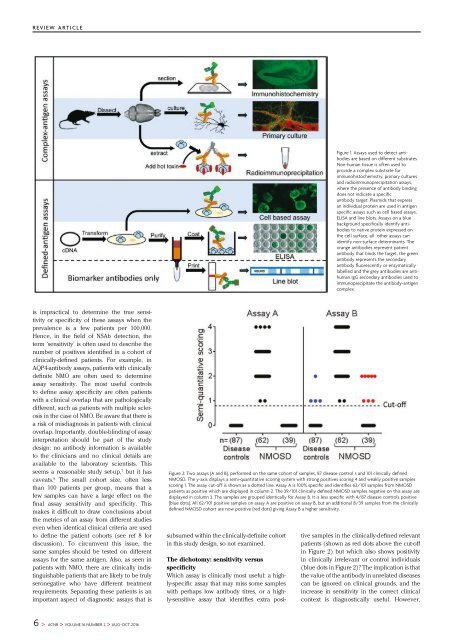In this issue
ACNR-ASO16-full-pdf-2
ACNR-ASO16-full-pdf-2
You also want an ePaper? Increase the reach of your titles
YUMPU automatically turns print PDFs into web optimized ePapers that Google loves.
e v i e w a r t i c l e<br />
Figure 1. Assays used to detect antibodies<br />
are based on different substrates.<br />
Non-human t<strong>issue</strong> is often used to<br />
provide a complex substrate for<br />
immunohistochemistry, primary cultures<br />
and radioimmunoprecipitation assays,<br />
where the presence of antibody binding<br />
does not indicate a specific<br />
antibody target. Plasmids that express<br />
an individual protein are used in antigen<br />
specific assays such as cell based assays,<br />
ELISA and line blots. Assays on a blue<br />
background specifically identify antibodies<br />
to native protein expressed on<br />
the cell surface, all other assays can<br />
identify non-surface determinants. The<br />
orange antibodies represent patient<br />
antibody that binds the target, the green<br />
antibody represents the secondary<br />
antibody fluorescently or enzymatically<br />
labelled and the grey antibodies are antihuman<br />
IgG secondary antibodies used to<br />
immunoprecipitate the antibody-antigen<br />
complex.<br />
is impractical to determine the true sensitivity<br />
or specificity of these assays when the<br />
prevalence is a few patients per 100,000.<br />
Hence, in the field of NSAb detection, the<br />
term ‘sensitivity’ is often used to describe the<br />
number of positives identified in a cohort of<br />
clinically-defined patients. For example, in<br />
AQP4-antibody assays, patients with clinically<br />
definite NMO are often used to determine<br />
assay sensitivity. The most useful controls<br />
to define assay specificity are often patients<br />
with a clinical overlap that are pathologically<br />
different, such as patients with multiple sclerosis<br />
in the case of NMO. Be aware that there is<br />
a risk of misdiagnosis in patients with clinical<br />
overlap. Importantly, double-blinding of assay<br />
interpretation should be part of the study<br />
design: no antibody information is available<br />
to the clinicians and no clinical details are<br />
available to the laboratory scientists. This<br />
seems a reasonable study set-up, 7 but it has<br />
caveats. 8 The small cohort size, often less<br />
than 100 patients per group, means that a<br />
few samples can have a large effect on the<br />
final assay sensitivity and specificity. This<br />
makes it difficult to draw conclusions about<br />
the metrics of an assay from different studies<br />
even when identical clinical criteria are used<br />
to define the patient cohorts (see ref 8 for<br />
discussion). To circumvent <strong>this</strong> <strong>issue</strong>, the<br />
same samples should be tested on different<br />
assays for the same antigen. Also, as seen in<br />
patients with NMO, there are clinically indistinguishable<br />
patients that are likely to be truly<br />
seronegative who have different treatment<br />
requirements. Separating these patients is an<br />
important aspect of diagnostic assays that is<br />
Figure 2: Two assays (A and B), performed on the same cohort of samples, 87 disease control s and 101 clinically defined<br />
NMOSD. The y-axis displays a semi-quantitative scoring system with strong positives scoring 4 and weakly positive samples<br />
scoring 1. The assay cut-off is shown as a dotted line. Assay A is 100% specific and identifies 62/101 samples from NMOSD<br />
patients as positive which are displayed in column 2. The 39/101 clinically defined NMOSD samples negative on <strong>this</strong> assay are<br />
displayed in column 3. The samples are grouped identically for Assay B. It is less specific with 4/87 disease controls positive<br />
(blue dots). All 62/101 positive samples on assay A are positive on assay B, but an additional 8/39 samples from the clinically<br />
defined NMOSD cohort are now positive (red dots) giving Assay B a higher sensitivity.<br />
subsumed within the clinically-definite cohort<br />
in <strong>this</strong> study design, so not examined.<br />
The dichotomy: sensitivity versus<br />
specificity<br />
Which assay is clinically most useful: a highly-specific<br />
assay that may miss some samples<br />
with perhaps low antibody titres, or a highly-sensitive<br />
assay that identifies extra positive<br />
samples in the clinically-defined relevant<br />
patients (shown as red dots above the cut-off<br />
in Figure 2) but which also shows positivity<br />
in clinically irrelevant or control individuals<br />
(blue dots in Figure 2)? The implication is that<br />
the value of the antibody in unrelated diseases<br />
can be ignored on clinical grounds, and the<br />
increase in sensitivity in the correct clinical<br />
context is diagnostically useful. However,<br />
6 > ACNR > VOLUME 16 NUMBER 2 > AUG-OCT 2016


